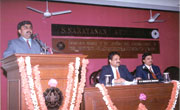The Bangalore branch of the Institute of Chartered
Accountants of India (ICAI) was established in April 1962, with just 110 member |
Chartered Accountants on its rolls. Today the Bangalore Chapter boasts of a
membership of over 4,000 members of whom 60% are in practice and 40% in industry, making
it the largest branch of ICAI in India.
This prestigious branch is headed by its Chairman, Ashok Raghavan. At 34, Ashok is
one of the youngest Chartered Accountants to hold the Chairmanship of the
organisation. His educational career, entirely in Bangalore, spans from his schooling at
Bishop Cottons and St.Josephs, a graduate degree in Commerce from the Bangalore
University and then the F.C.A. From being Director of Youth Services of the Rotary club,
the other posts in public life he has held include being Secretary of the Southern India
Chartered Accountants Students Association, then Treasurer and Vice-President of ICAI,
Bangalore, before being elected its Chairman this year. A keen lover of tennis he has
taken part in State level tournaments during his college years.
|

|
|

|
Online
Bangalore caught up with this young and dynamic head honcho of the ICAI in his office
where he practices his trade as partner of M/s. N.C.S.Raghavan and Co., and M/s. Raghavan,
Chaudhuri and Narayanan, Chartered Accountants. In this exclusive and candid interview,
Ashok Raghavan explains the monograph on 'Accounting for dot com companies' which was
recently handed over to the Securities and Exchange Board chief by the ICAI, New Delhi. He
also discusses the recent announcement by ICAI that Chartered accountants are permitted to
host web sites and the guidelines and restrictions that they are subjected to.
|
|
The interview also
features his views on the new CA exam format and activities conducted by the ICAI branch. |
Is the monograph on 'Accounting for Dot com Companies' the result of
SEBI's Subcommittee appointed last year?
Yes. But what has been presented is only a monograph.
What is a monograph?
It is the first step in the process before it becomes an accepted Accounting
Standard.
What are the other steps?
After the preparation of the monograph, it is then published in the Chartered
Accountants Journal as an Exposure Draft. After its publication, the comments and
suggestions of the various member CA's on the issue is considered and the necessary
changes are made. Only then will it then be eligible to become an
Accounting Standard.
When will it be finally implemented?
This whole procedure may take about two months. It will then become the 21st
Accounting Standard after the new proposed Standard on "Accounting for taxes on
Income".
What is the main focus of the monograph?
It mainly deals with accounting by dot com companies in respect of certain issues
relating to revenue and expense recognition due to the new business models used by them
like advertising partnerships, point and loyalty programmes and rebates and discounts. For
this purpose dot com companies have been classified into two types.
What are they?
One is Online -Content companies and the other is the Internet Commerce
companies. While the first type focus on the Internet sites that provide news, information
and knowledge as their main business and also provide Internet Navigation Services and
reference guide information for the World Wide Web and that publish, present or provide
proprietary, advertising and or third party content. Examples are yahoo, indiainfoline and
askjeeves. The Internet commerce companies sell products and services over the websites on
the Internet and include on-line dealers, and on this basis the transactions are divided
into B2B, B2C, C2C and C2B. E.g. being commodityindia.com, fabmart.com, bazee.com and
priceline.com respectively.
How
has the types of revenue generated by dotcoms been classified?
They have been listed as Membership and subscription, Merchandising activities
Advertising services and other Services like web hosting, content selling etc.
Has the issue of gross revenue in the case of online sale of high value
goods like air tickets, electronic items and computer hardware been resolved? Especially
if the seller is only an agent and not the principal?
Yes. Revenue that has been generated from the above four sources is measured by the
charges made to customers or clients for goods supplied and services rendered to them and
by the charges and rewards arising from the use of resources by them. In an agency
relationship, the revenue is the amount of commission and NOT the gross inflow of cash,
receivables or other considerations.
Will this take care of the gross revenue calculations earlier used to
hike up the valuation of dot coms?
Yes. It certainly will. Because if the company is not a principal of the goods or
service, the revenue has to be calculated as commission only and not gross. Therefore
companies acting as agents only will not be henceforth able to show hiked up gross revenue
figures for valuation.
How has revenue from sales or service transactions been recognised?
This revenue is recognised when the requirements as to performance have been
satisfied. That is, firstly, the seller of the goods has transferred to the buyer the
property in the goods for a price and secondly, no uncertainty exists regarding the amount
of the consideration that will be derived from the sale. In the rendering of services,
performance is measured under the 'completed services contract method' or the
'proportionate completion method, whichever relates to the revenue to the work
accomplished.
What about source of revenue from Membership and subscription?
These have been categorised as
1) Non Refundable fee with payment for other services.
2) Non - refundable fee without payment for other services.
3) Non- refundable fee entitling usage of services for a specified period.
4) Refundable fee subject to fulfillment of conditions in the subscription agreement.
5) Periodic fee on monthly, quarterly or annual basis.
In those cases where the services have to be paid for separately, the non- refundable fee
should be capitalised. In the case where the fee covers usage of services too, the
recognition of such fees should be generally deferred and should be recognized
systematically over the period.
How has advertising revenue been recognised?
Advertising services are a main source of revenue either through banner ads or
sponsorship advertising. The revenue is recognised on the basis of 'No of Impressions' or
'Click-throughs', on straight-line basis for 'Display banners' or ' barter-transactions',
considering that the fair value of the transactions have occurred not less than six months
preceding the sale of similar advertising to unrelated buyers. The fair value of
advertising space in a barter transaction depends on the space being in the same media and
vehicle and the 'characteristics' of such similar space.
What are the characteristics considered?
They are
1) Circulation, exposure or saturation within an intended market.
2) Timing i.e., time of day, day of week. Daily/Weekly, 24 hours a day/7 days a week and
season of the year.
3) Prominence. i.e., page on website, section, location on page and size of advertisement.
4) Demographics of readers, viewers or customers.
5) Duration of the advertisement.
And what of revenue from 'other sources' like web-hosting services and
content selling?
Revenue from webhosting services should be recognised over the period for which
the website is to be hosted or maintained provided they are rendered over the period of
the contract, unless other systematic and rational basis of revenue recognition is more
representative of the service provided.
In the case of web Content selling for a price, a downloading facility is available to the
purchaser, and the content is to be considered sold when the content is delivered to the
purchaser, determining the time at which the delivery is considered complete and recognize
the corresponding revenue.
How has Costs been recognised and calculated?
The costs characteristic to dotcoms have been classified as
1) Website development costs
2) Discounts, rebates and other sales incentives
3) Points and loyalty programme.
The website development costs including planning, registering domain name, testing
applications, and creating initial content should be amortised over a period not
exceeding 2 years and shown as deferred revenue expenditure under the head 'Miscellaneous
Expenditure". All costs incurred after the first Website is opened to users should be
expensed in the period in which they are incurred. Free or heavily discounted prices, such
value should be reduced from revenue. Any other forms of discount should be treated as a
selling and marketing expense and disclosed separately in the profit and loss account.
Regarding hosting of websites by Chartered Accountants, what are the
guidelines?
Our National President Mr. Gupta made this landmark announcement, when he visited
Bangalore branch this February. Unlike other trades and professionals, we are not
allowed to advertise our services and therefore the guidelines strictly set down
regulations to prevent misuse of the website. For e.g. No photographs or logos are
allowed. No advertisement banners are allowed. And nature of assignments handled to be
displayed only on specific pull request.
Does the ICAI have any specific grievance that you have notified the
government?
Yes. It is the considered view of the Institute that Tax audit should be
performed exclusively by Chartered Accountants. This is because doubts were
expressed that Tax audit could be done by sales tax practitioners also. We have made a
representation to the Government regarding this. The government has recognized our
grievance by the proposed amendments to the section 44 AB of the Income tax Act, in the
Finance Bill 2001.
What are the management development programmes conducted by ICAI
Bangalore?
We have 2 specialised programmes. One is a course on Finance for non- finance
Executives, which is a 6month part time course and the course fee is Rs.7500. The other is
a course in Corporate Accounting, Finance and Business Laws (CCAFBL) for Finance
professionals, which is also a 6-month, part time course and the course fee is Rs.12500.
We have also conducted training to employees of various corporates including BSNL, KPTCL,
Times of India Group etc.
Are there any changes in the format of the CA Examination?
Yes. Effective November 2002, the 'Intermediate' part of the examination will be
replaced by a 'Prep I' and a 'Prep II' exam, followed by certified articleship for 3
years and only then the final exam can be taken by the students.
|
|